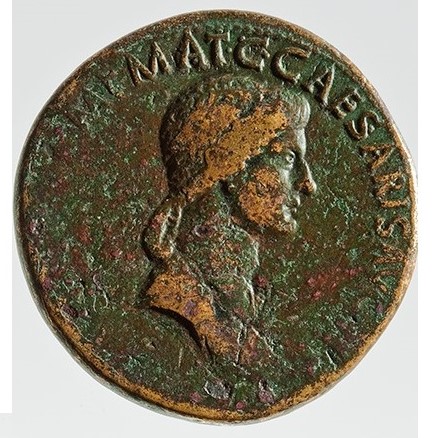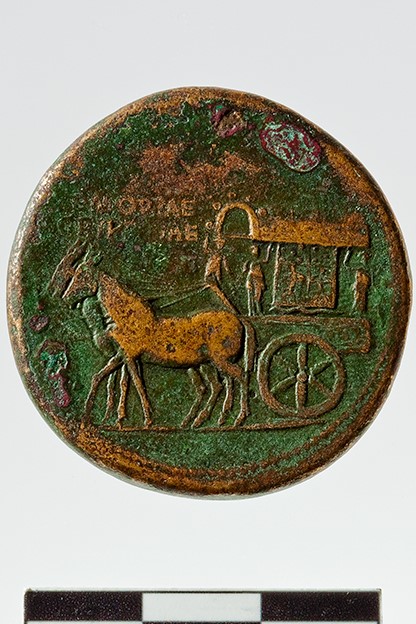Acquisition number: 1968.26
Obv.: Bust of Agrippina (the Elder) r., hair pulled back in chignon on neck. [AGRIPPINA] M(arci) F(ilia) MAT(er) C(ai) CAESARIS AVG[VSTI].
Rev.: Carpentum drawn l. by two mules. Female figures support roof at three corners. Through the side of carriage can be seen two figures (dancing?) and two stars. In field, [S(enatus) P(opulus) Q(ue) R(omanus)] MEMORIAE AGRIPPINAE.
Title: Sestertius of Agrippina, reign of Gaius - 1968.26
Acquisition number: 1968.26
Author or editor: Beryl Rawson
Culture or period: Roman Imperial
Date: AD 37-41
Material: Metal - Brass
Object type: Coins - Roman
Dimensions: 33mm (w)
Origin region or location: Italy
Origin city: Rome
Display case or on loan: 5
Keywords: Coin, sestertius, Roman, Imperial, Agripinna the Elder, Caligula
Sear, D.R., Roman Coins and their Values 5 vols (London, Spink, 2000-2014) 1827; Mattingly, H., E.A. Sydenham, C.H. Sutherland, R.A. Carson, The Roman Imperial Coinage 13 vols (London, Spink, 1923-1994) 55; Mattingly, H.,Coins of the Roman Empire in the British Museum, 6 vols (London, 1965) 81; Giard, J.-P., Catalogue des Monnaies de l’Empire Romain 3 vols (Paris: Bibliothèque Nationale, 1988-1998) 128, C Agrippina Senior 1. [Rome, AD 37-41].
Breglia, L., Roman Imperial Coins: Their Art and Technique (New York, F.A. Praeger, 1968) 46-47 (incl. pll.); Giacosa, G., Ritratti di Auguste (Milan, Arte e Moneta, 1974) 29 and pll. VIII, IX; Wood, S., ‘Memoriae Agrippinae: Agrippina the Elder in Julio-Claudian art and propaganda’, American Journal of Archaeology 92, no. 3 (1988), 409–426; Ginsburg, J., Representing Agrippina: constructions of female power in the early Roman Empire (Oxford University Press, 2005); Sutherland, C.H.V., Roman Coins (London, Putnam, 1974) 152-153 and pl. 292.
1968.26
Sestertius of Agrippina, reign of Gaius
23.176 g. AD 37-41
Obv.: Bust of Agrippina (the Elder) r., hair pulled back in chignon on neck. [AGRIPPINA] M(arci) F(ilia) MAT(er) C(ai) CAESARIS AVG[VSTI].
Rev.: Carpentum drawn l. by two mules. Female figures support roof at three corners. Through the side of carriage can be seen two figures (dancing?) and two stars. In field, [S(enatus) P(opulus) Q(ue) R(omanus)] MEMORIAE AGRIPPINAE.
Gaius celebrated many members of his family on his coins. Agrippina, here celebrated as ‘mother of Caesar (= Gaius)’, had been the wife of Germanicus, who died in Syria in AD 19. She was exiled by Tiberius in AD 29 and died in AD 33. On his accession Gaius brought back her ashes to Rome, had them placed in Augustus’ mausoleum, and instituted games in her honour (Suetonius Gaius 15). The carpentum was a two-wheeled covered carriage used by high-ranking women in the city and often associated with funeral rites. (Agrippina’s image was to be carried in a carpentum at her games.) Tiberius had put a similar type on a coin issued in honour of his mother Livia in AD 22 (cf. on 1972.03).
As Grant points out (144), ‘This coin marks an advance in the honouring of imperial women’. Previously, there had been the anonymous portrait of Livia (cf. 1972.03) or only full-length figures with explicit names (cf. 1974.05). Here we have a portrait, with name attached, and there is no head or titles of the emperor on the coin. This is, however, a posthumous issue. It remained for Agrippina’s daughter, Agrippina the Younger, to be the first living woman to have her portrait and name on coins issued at Rome.
The portrait of Agrippina is excellent and was probably made from a sculptured bust. On most coins of this type there is a single ringlet down her neck in front of the chignon, but this coin is worn in that place.
Sear, D.R., Roman Coins and their Values 5 vols (London, Spink, 2000-2014) 1827; Mattingly, H., E.A. Sydenham, C.H. Sutherland, R.A. Carson, The Roman Imperial Coinage 13 vols (London, Spink, 1923-1994) 55; Mattingly, H.,Coins of the Roman Empire in the British Museum, 6 vols (London, 1965) 81; Giard, J.-P., Catalogue des Monnaies de l’Empire Romain 3 vols (Paris: Bibliothèque Nationale, 1988-1998) 128, C Agrippina Senior 1. [Rome, AD 37-41].
Breglia, L., Roman Imperial Coins: Their Art and Technique (New York, F.A. Praeger, 1968) 46-47 (incl. pll.); Giacosa, G., Ritratti di Auguste (Milan, Arte e Moneta, 1974) 29 and pll. VIII, IX; Wood, S., ‘Memoriae Agrippinae: Agrippina the Elder in Julio-Claudian art and propaganda’, American Journal of Archaeology 92, no. 3 (1988), 409–426; Ginsburg, J., Representing Agrippina: constructions of female power in the early Roman Empire (Oxford University Press, 2005); Sutherland, C.H.V., Roman Coins (London, Putnam, 1974) 152-153 and pl. 292.

